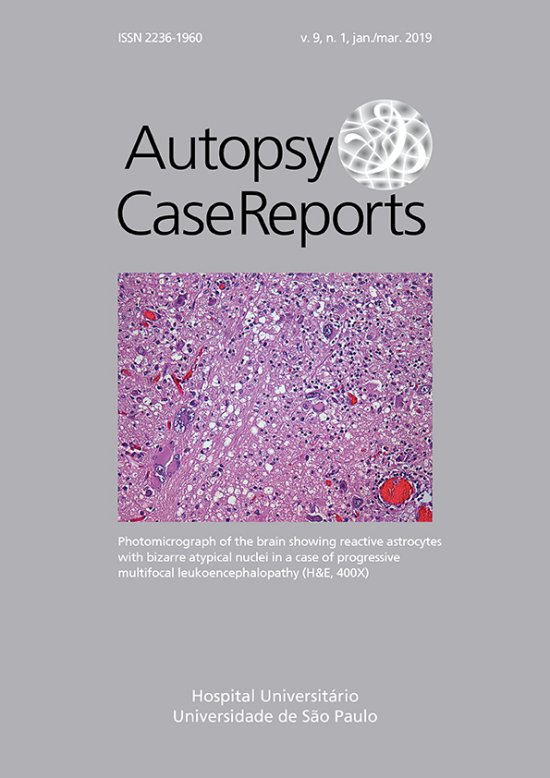Spontaneous perforation of small intestine followed by rupture of the cystic artery: the natural history of Vascular Ehlers-Danlos Syndrome
DOI:
https://doi.org/10.4322/acr.2018.054Keywords:
Aneurysm, False, Ehlers-Danlos Syndrome, Intestinal Perforation, DissectingAbstract
Vascular Ehlers-Danlos Syndrome (VEDS) is a rare autosomal dominant disorder caused by mutations in the COL3A1 or COL1A1 genes. Its mortality is secondary to sudden and spontaneous rupture of arteries or hollow organs. The genotype influences the distribution of arterial pathology with aneurysms of intra-abdominal visceral arteries being relatively uncommon. We describe the case of a young man with probable VEDS who died of a spontaneous rupture and dissection of the cystic artery. The patient initially presented with abdominal pain due to an unrecognized spontaneous perforation of the small intestine complicated by sepsis. We postulate that inflammatory mediators may have triggered the arterial rupture due to remodeling and weakening of vessel walls. The phenotype of the patient’s vascular damage included bilateral spontaneous carotid-cavernous sinus fistulae and dissection with pseudoaneurysm formation of large- and medium-sized arteries, predominantly the abdominal aorta and its branches. The autopsy uncovered a long history of vascular events that may have been asymptomatic. These findings along with a positive family history supported the VEDS diagnosis. Loeys-Dietz, Marfan, and familial thoracic aortic aneurysm and dissection syndromes were ruled out based on the absence of arterial tortuosity, eye abnormalities, bone overgrowth, and the distribution of vascular damage among other features. Interestingly, microscopic examination of the hippocampus revealed a focus of neuronal heterotopia, commonly associated with epilepsy; however, the patient had no history of seizures. The natural course of VEDS involves the rupture and dissection of arteries that, if unrecognized, can lead to a rapid death after bleeding into free spaces.
Downloads
Published
Issue
Section
License
Copyright
Authors of articles published by Autopsy and Case Report retain the copyright of their work without restrictions, licensing it under the Creative Commons Attribution License - CC-BY, which allows articles to be re-used and re-distributed without restriction, as long as the original work is correctly cited.



